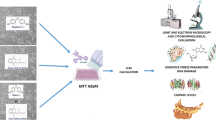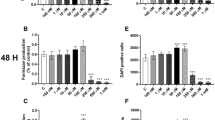Abstract
Phthalate esters are widespread in the environment. They have been described as being one of the most abundant man-made environmental contaminants that may be adverse to human health. Particularly, di-2-ethylhexyl phthalate (DEHP) has been shown to cause reproductive and developmental toxicity and is suspected to be an endocrine disruptor. The primary objective of this study is to determine the estrogenic activity of DEHP. Estrogenic activities of DEHP were studied by in vitro assays of human breast cancer MCF-7 cell proliferation. Estrogen-dependent MCF-7 cells were grown in RPMI1640 medium containing 10% fetal bovine serum. Five days before the addition of the test compounds, the cells were washed by phosphate balanced solution (PBS), and the medium was substituted with a phenol red-free RPMI1640 medium containing 5% dextral charcoalstripped Fetal Bovine Serum (FBS). Fresh medium was added to the respective test compounds and the control cell received only the vehicle (ethanol). The proliferation of MCF-7 cell was analyzed by the MTT assay, growth curves, mitotic index and colony forming efficiency. Compared with the ethanol control cells, the proliferation of tested cells treated with DEHP, like estradiol, was significantly enhanced and the activity of the cell proliferation reached the maximum at 1 × 10−3 mol/L DEHP. The relative proliferative potency of DEHP was 0.000 001 with a relative proliferative effect of 97.32%. During the log phase, the mitotic index of the tested cells treated with DEHP and estradiol was significantly increased. The cell cloning efficiency was enhanced, which was treated by 10−3 mol/L DEHP only for 48 hours. The results show a time-dependent and dose-dependent model. Di-2-ethylhexyl phthalate enhanced the proliferation of human breast cancer MCF-7 cells in vitro and might demonstrate an estrogenic activity.
Similar content being viewed by others
References
U.S. Environmental Protection Agency. Special report on environmental endocrine disruption: an effects assessment and analysis, EPA/630/R-96/012. 1997. http://www.epa.gov/ORD/WebPub-s/endocrine/endocrine.pdf.
Bauer M J, Herrmann R. Estimation of the environmental contamination by phthalic acid esters leaching from household wasters. Sci Total Environ, 1997, 208(1–2): 49–57
Yuan S Y, Liu C, Liao C S, Chang B V. Occurrence and microbial degradation of phthalate esters in Taiwan river sediments. Chemosphere, 2002, 49(10): 1295–1299
Marttinen S K, Kettunen R H, Rintala J A. Occurrence and removal of organic pollutants in sewages and landfill leachates. Sci Total Environ, 2003, 301(1–3): 1–12
Petersen J H, Breindahl T. Plasticizers in total diet samples, baby food and infant formulae. Food Addit Contam, 2000, 17(2): 133–141
Staples C A, Parkerton T F, Peterson D R. A risk assessment of selected phthalate esters in North American and western European surface waters. Chemosphere, 2000, 40(8): 885–891
Foster P M, Mylchreest E, Gaido K W, Sar M. Effects of phthalate esters on the developing reproductive tract of male rats. Hum Reprod Update, 2001, 7(3): 231–235
Sharpe R M. Hormones and Testis Development and the Possible Adverse Effects of Environmental Chemicals. Toxicol Lett, 2001, 120(2): 221–232
Soto A M, Sonnenschein C, Chung K L, Fernandez M F, Olea N, Serrano F O. The E-SCREEN assay as a tool to identify estrogens: an update on estrogenic environmental pollutants. Environ Health Perspect, 1995, 103(Suppl 7): 113–122
Gutendorf B, Westendorf J. Comparison of an array of in vitro assays for the assessment of the estrogenic potential of natural and synthetic estrogens, phytoestrogens and xenoestrogens. Toxicology, 2001, 166(1–2): 79–89
Shen L J, Zhou Y F, Jin T J. Experimental study on the estrogen-like effect of cadmium. Huanjing Yu Zhiye Yixue, 2001, 18(2): 67–69 (in Chinese)
Okubo T, Suzuki T, Yokoyama Y, Kano K, Kano I. Estimation of estrogenic and anti-estrogenic activities of some phthalate diesters and monoesters by MCF-7 cell proliferation assay in vitro. Biol Pharm Bull, 2003, 26(8): 1219–1224
Jobling S, Reynolds T, White R, Parker M G, Sumpter J P. A variety of environmentally persistent chemicals, including some phthalate plasticizers, are weakly estrogenic. Environ Health Perspect, 1995, 103(6): 582–587
Harris C A, Henttu P, Parker M G, Sumpter J P. The estrogenic activity of phthalate esters in vitro. Environ Health Perspect, 1997, 105(8): 802–811
McLachlan J A. Environmental signaling: what embryos and evolution teach us about endocrine disrupting chemicals. Endocr Rev, 2001, 22(3): 319–341
Colborn T, vom Saal F S, Soto A M. Developmental effects of endocrine-disrupting chemicals in wildlife and humans. Environ Health Perspect, 1993, 101(5): 378–384
Davis B J, Maronpot R R, Heindel J J. Di (2-ethylhexyl) phthalate suppresses estradiol and ovulation in cycling rats. Toxicol Appl Pharmacol, 1994, 128(2): 216–233
Ishihara M, Itoh M, Miyamoto K, Suna S, Takeuchi Y, Takenaka I, Jitsunari F. Spermatogenic disturbance induced by di-(2-ethylhexyl) phthalate is significantly prevented by treatment with antioxidant vitamins in the rat. Int J Androl, 2000, 23(2): 85–94
Lovekamp-Swan T, Davis B J. Mechanisms of phthalate ester toxicity in the female reproductive system. Environ Health Perspect, 2003, 111(2): 139–146
Lampen A, Zimnik S, Nau H. Teratogenic phthalate esters and metabolites activate the nuclear receptors PPARs and induce differentiation of F9 cells. Toxicol Appl Pharmacol, 2003, 188(1): 14–24
Gazouli M, Yao Z X, Boujrad N, Corton J C, Culty M, Papadopoulos V. Effect of peroxisome proliferation on Leyding cell peripheral-type benzodiazepine receptor gene expression, hormone-stimulated cholesterol transport, and steroidogenesis: role of the peroxisome proliferation-activator receptor alpha. Endocrinology, 2002, 143(7): 2571–2581
Nadal A, Ropero A B, Laribi O, Maillet M, Fuentes E, Soria B. Nongenomic actions of estrogens and xenoestrogens by binding at a plasma membrane receptor unrelated to estrogen receptor alpha and estrogen receptor beta. Proc Natl Acad Sci USA, 2000, 97(21): 11603–11608
Lauber S N, Ali S, Gooderham N J. The cooked food derived carcinogen 2-amino-1-methyl-6-phenylirnidazo [4,5-b] pyridine is a potent oestrogen: a mechanistic basis for its tissue-specific carcinogenicity. Carcinogenesis, 2004, 2512(12): 2509–2517
Mendez P, Azcoitia I, Garcia-Segura L M. Estrogen receptor [alpha] forms estrogen-dependent multimolecular complexes with insulin-like growth factor receptor and phosphatidylinositol 3-kinase in the adult rat brain. Brain Res Mol, 2003, 112: 170–176
Author information
Authors and Affiliations
Corresponding author
Rights and permissions
About this article
Cite this article
Jin, Q., Sun, Z. & Li, Y. Estrogenic activities of di-2-ethylhexyl phthalate. Front. Med. China 2, 303–308 (2008). https://doi.org/10.1007/s11684-008-0058-2
Received:
Accepted:
Published:
Issue Date:
DOI: https://doi.org/10.1007/s11684-008-0058-2




